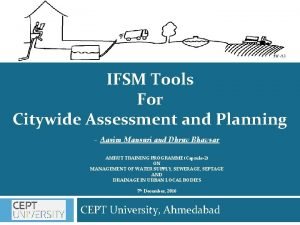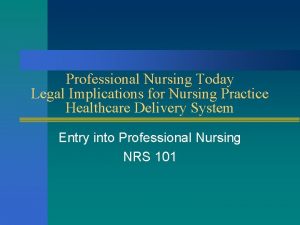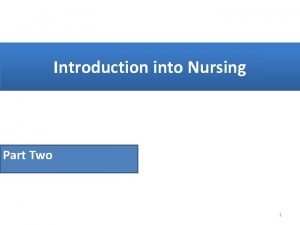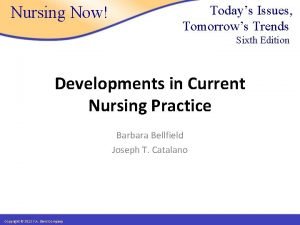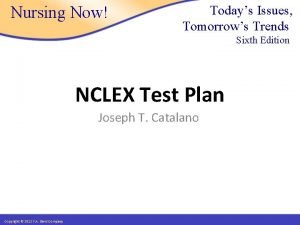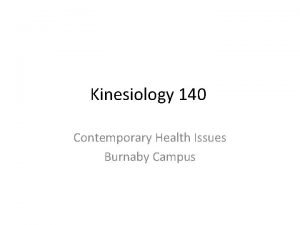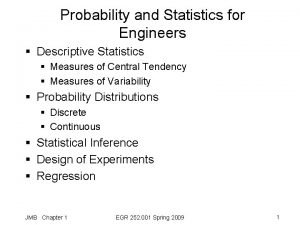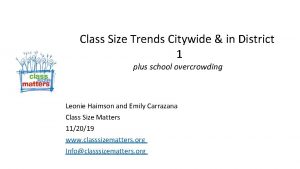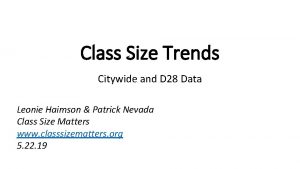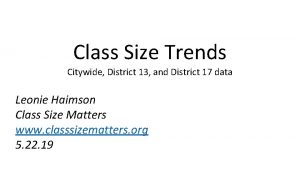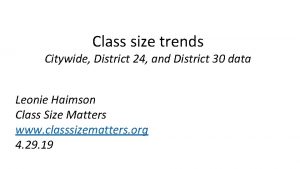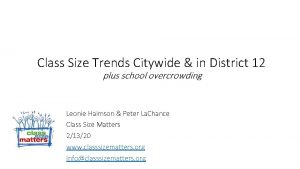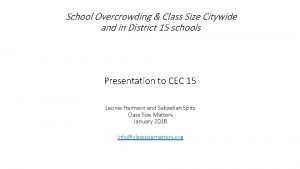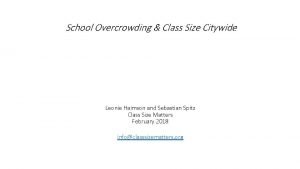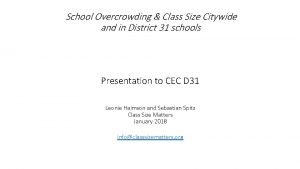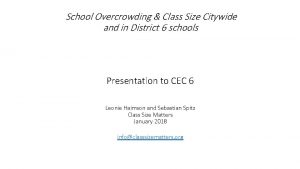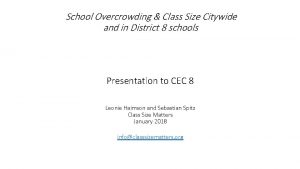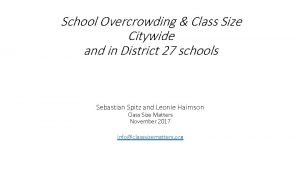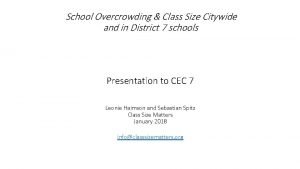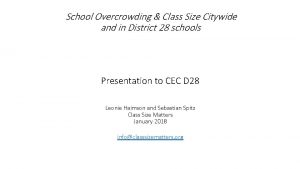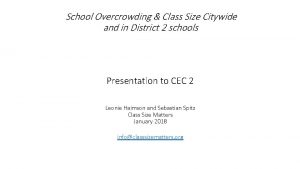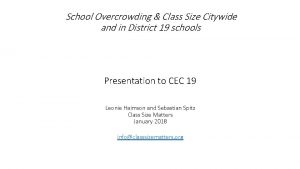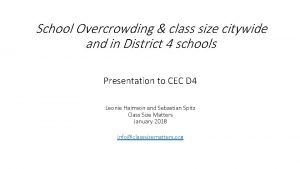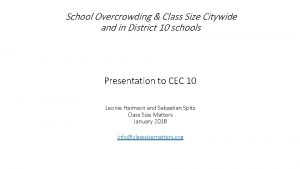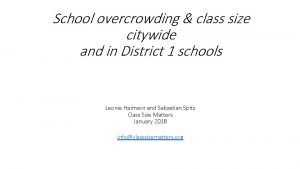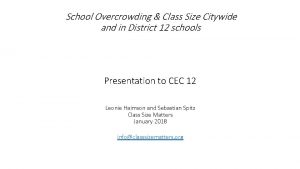Class Size Trends Citywide Other Related Issues 2007




























- Slides: 28

Class Size Trends Citywide & Other Related Issues 2007 -2019 Leonie Haimson and Emily Carrazana Class Size Matters 11/20/10 www. classsizematters. org Info@classsizematters. org

25 students per class in Kindergarten What are the UFT contractual class sizes limits? 32 students per class in grades 1 st-5 th grades In Title I MS, 31 students per class in 6 th-8 th grades , 33 in non-Title one schools 34 students per class in high school core academic classes These class size caps have not been lowered in 50 YEARS! Even so, hundreds of classes violate the union contractual caps each year.

At least 820 classes* violated UFT class size limits as of Oct. 31, 2019 200 178 180 160 140 125 123 146 113 88 100 80 47 60 40 20 0 K (*Using 1 st-3 rd 4 th-8 th HS ELA HS math HS science HS soc scie 33 students as cap for non-Title I MS; using 31 for Title I MS, there would be 569 more classes)

In 2007, NYS Legislature passed a new law called the Contracts for Excellence (C 4 E)

C 4 E law states that in return for millions in new state funding, NYC has a legal obligation to: 1. Spend the funds to improve school conditions in six specified areas. 2. Create a plan to reduce class sizes in all grades over five years. 3. In 2007, NYC submitted a 5 -yr plan to reduce class sizes to no more than 20 in grades K-3; 23 in grades 4 -8 and 25 in core HS classes. 4. Yet instead of decreasing, class sizes increased sharply, starting in 2008.

This year’s class size data was just released and shows a small increase in average class sizes citywide in Kindergarten and 7 th grade; other grades no change or small decreases.

Average K-3 Class Sizes Increased 14% since 2007 29 27 25 23 24. 5 24. 9 24. 7 24. 6 24. 2 24. 0 23. 923. 8 23. 9 22. 1 20. 9 21. 4 20. 7 20. 5 20. 3 20. 1 19. 9 19. 919. 9 21 19 17 C 4 E Goals Citywide actual 0 -2 20 19 -9 18 20 17 -1 16 20 20 15 -1 6 5 -1 14 20 20 13 -1 4 3 -1 20 12 2 -1 20 11 1 -1 20 10 0 -1 20 09 -9 08 20 20 07 -8 15

Average 4 th-8 th Class Sizes Increased 6% Since 2007 28 27 26 25. 8 25. 3 25 25. 1 24 24. 8 24. 6 26. 3 23. 8 23. 3 23 26. 6 26. 7 26. 8 26. 7 26. 6 26. 5 22. 9 22 21 C 4 E Goals Citywide actual 02 -2 19 20 18 -2 01 0 9 8 20 20 17 -1 7 20 16 -1 6 20 15 -1 5 20 14 -1 4 20 13 -1 3 20 12 -1 2 20 11 -1 1 20 10 -1 20 09 -9 08 20 20 07 -8 20

Average HS Class Sizes Increased 2% Since 2007 27 26. 8 26. 7 26. 6 26. 1 26. 5 26. 4 26. 3 26. 2 26 25. 7 25. 2 24. 8 24. 5 24. 5 26 25. 5 25 24 23. 5 C 4 E Target 0 -2 20 01 -2 18 20 Citywide Actual 19 9 8 -1 17 20 20 16 -1 7 6 -1 20 15 5 14 -1 4 20 20 13 -1 3 20 12 -1 2 20 11 -1 1 20 10 -1 0 09 -1 9 20 -0 08 20 20 07 -0 8 23

But average class sizes only tell part of the story! The total number of students in classes of 30 or more citywide has also increased since 2007.

Number of Kindergarten students in classes of 25 or more has increased 68% since 2007 20, 000 18, 768 18, 000 16, 000 14, 000 12, 000 11, 174 10, 000 8, 000 6, 000 4, 000 2, 000 0 2007 2019

Number of 1 st-3 rd graders in classes of 30 or more has increased by 2893% since 2007 40, 000 35, 471 35, 000 30, 000 25, 000 20, 000 15, 000 10, 000 5, 000 1, 185 0 2007 2019

Number of 4 th-8 th graders in classes of 30 or more has increased by 35% since 2007 112, 250 83, 055 2007 2019

At least *275, 780 NYC students in classes of 30 or more as of Oct. 31, 2019 140, 000 127, 780 112, 250 120, 000 100, 000 80, 000 60, 000 40, 000 35, 562 20, 000 0 K-3 *Only 4 th-8 th HS (min) HS students in social studies classes included to avoid double counting

School overcrowding also an issue in many districts • Latest Blue Book for 2018 -2019 shows that there were 515, 898 students in NYC overcrowded schools • Though in some districts, there would be space to lower class size right now.

So what are we doing about this? • . In July 2017, CSM along with 9 NYC parents & AQE filed a complaint with the State Education Commissioner to demand they enforce the C 4 E and require NYC to lower class size. In April 2018, after the Commissioner ruled against us, so we followed up with a lawsuit vs. the city and the state in the NYS Supreme Court. Though Judge Henry Zwack ruled that the Commissioner’s decision to allow NYC to increase class size should be given deference, we appealed the case to the Appellate Court in May 2019. Hearings will be held at the NY Appellate Court in Albany in January 2020.

What does DOE say in court, in arguing they don’t need to lower class size? • DOE claims that then-Commissioner Steiner gave them a waiver from reducing class size in 2010. • BUT: Commissioner Steiner clearly stated this was a temporary waiver , due to the economic recession which ended a decade ago. • In any case, neither Steiner nor the current Commissioner has the authority to waive the law. • The DOE also argues that any class size obligations lapsed at the end of the 2011 -2012 school year; even though the state legislature renews the C 4 E law every year, including the part of the law requiring NYC to lower class size. • DOE also claims though they may have had an obligation to create a plan, they didn’t have to follow it!

What else are we doing? • We had a campaign last year to urge the City Council to allocate dedicated funding to be used to reduce class size, especially in struggling schools to begin with and in the lower grades. • We were unable to convince them but plan to push for this in next year’s budget. • Please join our campaign by passing a resolution and contacting your CMs to support this effort.

We also released a report on charter facility funding last month. • State law passed in 2010 requires matching funds for facility upgrades for public schools co-located with charter schools, for every expenditure by charters for facility renovations over $5000. • We found that FY 2014 to FY 2019, about $22. 1 million in charter school expenditures on facility upgrades were not matched in the public schools that shared their buildings, a shortfall of about 14%

Millions Missing Matching funds per year, FY 2014 -2019 (in millions) ($22. 1 million total) $6. 5 $6. 4 FY 2018 FY 2019 $4. 6 $1. 3 FY 2014 $1. 7 $1. 6 FY 2015 FY 2016 FY 2017 Source: DOE Charter Matching Tracker FY 2014 to FY 2019

In 2014, the state passed a law stating that NYC must either provide charter schools space in public school buildings or help them pay for private space NYC is the only district in the state and the country with this legal obligation. We found that the cost of leasing private buildings for charters and providing them a per-student subsidy to allow them to rent their own buildings has risen sharply, and was over $100 M last year; This annual amount if used to finance the school capital plan could fund a 50% increase in school seats to be built to relieve overcrowding.

We also found that DOE is helping to pay for 8 Charters though their buildings owned related parties ● ● This means the building is owned by their charter management organizations or an affiliated LLC or foundation. The total for such expenditures amounts to about $14. 8 million in DOE expenditures since FY 2015

Examples: Success Academy Hudson Yards ● DOE spent $2. 2 million for two Success Academy charter schools in FY 2019 located in Hudson Yards complex on the west side of Manhattan, the most expensive real estate development in NYC. ● Yet Success Academy Charter Management Organization purchased the space for $68 million in 2016, with at least $20 million donated by Robertson Foundation. ● In another case, the city paid $461, 965 in lease subsidies in FY 2019 towards the rental costs of Beginning with Children II charter school in Brooklyn. ● Real estate records show Beginning with Children Foundation bought the building for only $10 in 2017 from the Pfizer Corporation.

Harlem Village Academy ● Since FY 2015, the DOE has provided per-student lease subsidies of nearly $3. 2 million to Harlem Village Academy – West (M 335) for an elementary school located on 74 West 124 th Street. ● The building was purchased in 2012 by “HVA 124 LLC” for $13 million according to property records, a limited liability company in which the HVA CMO is the sole member. This was before the charter amendment requiring subsidies was passed. ● Jonathan Gray COO of Blackstone donated $10 million for the purchase of the building and an additional $15 million for building renovations. ● Part of the renovation costs were also paid by federal New Market Tax credits.

Harlem Children’s Zone Promise Academy II ● ● Since FY 2015, the DOE has provided approximately $2. 1 million in lease subsidies to Harlem Children's Zone Promise Academy II Charter School (M 341) in a building on 35 East 125 th Street. According to city records, this building has been owned by “Rheedlen 125 th Street LLC” since 2000, which is a subsidiary of Harlem Children Zone network and their sole member.

Family Life Charter Schools ● ● ● Family Life Charter Schools (FLACS) received $862, 696 from DOE in lease subsidies in FY 2018. FLACs was founded in 2000 in partnership with the Latino Pastoral Action Center (LPAC), headquartered in the same building on 14 West 170 St. in the Bronx. Property records show the building is owned by LPAC and tax forms show that they receive rental income.

What are we doing about this? ● We are urging the NYC Comptroller to audit this spending of matching funds to see that they are equitable and fair ● And to look at DOE spending on leases for charter schools to see if we should be subsidizing the rent for charters that own their own buildings. ● We are also advocating for the State Legislature to change the charter law to relieve DOE’s obligations to provide space for charter schools in public school buildings or pay for their rent in private spaces. .

How you can help ● ● ● Pass a resolution and/or contact the Comptroller urging him to audit the city’s spending on charter facilities and renovation matching funds; Contact your state legislators to change the charter law to relieve DOE’s obligations to provide space for charter schools in public school buildings or pay for their rent in private spaces For more information or to subscribe to our newsletter, check out our website at www. classsizematters. org or e-mail us at info@classsizematters. org
 Citywide
Citywide How to find class interval
How to find class interval Two types of fitness components
Two types of fitness components Skill related fitness
Skill related fitness Legal implications in nursing practice
Legal implications in nursing practice Trends and issues in nursing
Trends and issues in nursing Nursing now today's issues tomorrow's trends
Nursing now today's issues tomorrow's trends Nursing now today's issues tomorrow's trends
Nursing now today's issues tomorrow's trends Ethical and social issues in information systems
Ethical and social issues in information systems Unbhr
Unbhr Issues or problems related to local governance/autonomy
Issues or problems related to local governance/autonomy Small atomic radius
Small atomic radius Size of the business in business description example
Size of the business in business description example Are height and shoe size related
Are height and shoe size related Bipolar and other related disorders
Bipolar and other related disorders Bipolar and other related disorders
Bipolar and other related disorders Const char *s =
Const char *s = Size classification is also known as size separation
Size classification is also known as size separation Self-initiated other-repair
Self-initiated other-repair 7 dimensions of wellness
7 dimensions of wellness What is the size of the class interval?
What is the size of the class interval? What is the size of the class interval?
What is the size of the class interval? Decision tree example of car type, shirt size and class
Decision tree example of car type, shirt size and class Today's classes
Today's classes Putting a package together
Putting a package together Abstract class vs concrete class
Abstract class vs concrete class Lower boundary of modal class
Lower boundary of modal class Class i vs class ii mhc
Class i vs class ii mhc Difference between abstract class and concrete class
Difference between abstract class and concrete class
